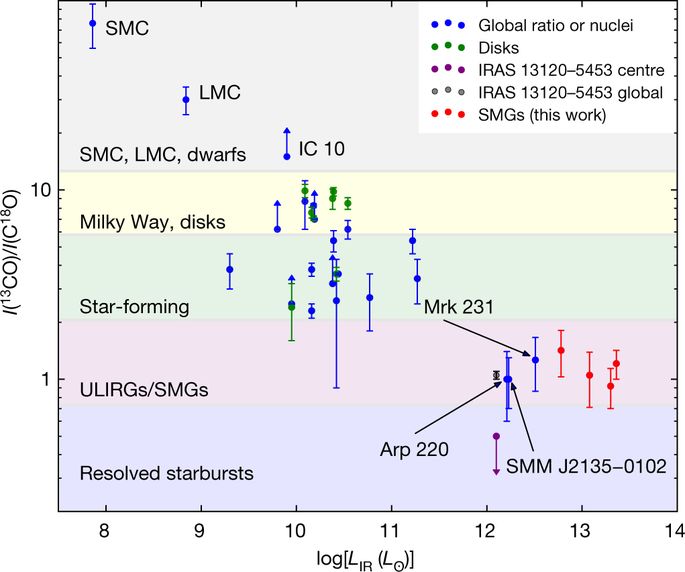Our official English website, www.x-mol.net, welcomes your
feedback! (Note: you will need to create a separate account there.)
Stellar populations dominated by massive stars in dusty starburst galaxies across cosmic time
Nature ( IF 50.5 ) Pub Date : 2018-06-01 , DOI: 10.1038/s41586-018-0196-x Zhi-Yu Zhang , D. Romano , R. J. Ivison , Padelis P. Papadopoulos , F. Matteucci
Nature ( IF 50.5 ) Pub Date : 2018-06-01 , DOI: 10.1038/s41586-018-0196-x Zhi-Yu Zhang , D. Romano , R. J. Ivison , Padelis P. Papadopoulos , F. Matteucci

|
All measurements of cosmic star formation must assume an initial distribution of stellar masses—the stellar initial mass function—in order to extrapolate from the star-formation rate measured for typically rare, massive stars (of more than eight solar masses) to the total star-formation rate across the full stellar mass spectrum1. The shape of the stellar initial mass function in various galaxy populations underpins our understanding of the formation and evolution of galaxies across cosmic time2. Classical determinations of the stellar initial mass function in local galaxies are traditionally made at ultraviolet, optical and near-infrared wavelengths, which cannot be probed in dust-obscured galaxies2,3, especially distant starbursts, whose apparent star-formation rates are hundreds to thousands of times higher than in the Milky Way, selected at submillimetre (rest-frame far-infrared) wavelengths4,5. The 13C/18O isotope abundance ratio in the cold molecular gas—which can be probed via the rotational transitions of the 13CO and C18O isotopologues—is a very sensitive index of the stellar initial mass function, with its determination immune to the pernicious effects of dust. Here we report observations of 13CO and C18O emission for a sample of four dust-enshrouded starbursts at redshifts of approximately two to three, and find unambiguous evidence for a top-heavy stellar initial mass function in all of them. A low 13CO/C18O ratio for all our targets—alongside a well tested, detailed chemical evolution model benchmarked on the Milky Way6—implies that there are considerably more massive stars in starburst events than in ordinary star-forming spiral galaxies. This can bring these extraordinary starbursts closer to the ‘main sequence’ of star-forming galaxies7, although such main-sequence galaxies may not be immune to changes in initial stellar mass function, depending on their star-formation densities.Observations of 13CO and C18O emission from four dusty starburst galaxies at redshifts of approximately two to three reveal that massive stars are more numerous in starburst events than in ordinary star-forming spiral galaxies.
中文翻译:

跨越宇宙时间的尘埃星暴星系中以大质量恒星为主的恒星群
宇宙恒星形成的所有测量都必须假设恒星质量的初始分布——恒星初始质量函数——以便从通常稀有的大质量恒星(超过八个太阳质量)测量到的恒星形成率外推到总恒星-整个恒星质谱的形成率1。不同星系群中恒星初始质量函数的形状巩固了我们对跨宇宙时间星系形成和演化的理解。局部星系中恒星初始质量函数的经典测定传统上是在紫外线、光学和近红外波长下进行的,而在尘埃遮蔽的星系 2,3 中无法探测,尤其是遥远的星暴,其表观恒星形成率为数百至数千比银河系高出数倍,选择亚毫米(静止帧远红外)波长 4,5。冷分子气体中的 13C/18O 同位素丰度比——可以通过 13CO 和 C18O 同位素体的旋转跃迁探测——是恒星初始质量函数的一个非常敏感的指标,其确定不受尘埃的有害影响. 在这里,我们报告了对 13CO 和 C18O 发射的观测结果,这些星暴样本的红移约为 2 到 3,并发现了所有这些星暴中头重脚轻的初始质量函数的明确证据。我们所有目标的低 13CO/C18O 比率——以及以银河系 6 为基准的经过充分测试的详细化学演化模型——意味着星暴事件中的恒星比普通恒星形成螺旋星系中的质量要大得多。
更新日期:2018-06-01
中文翻译:

跨越宇宙时间的尘埃星暴星系中以大质量恒星为主的恒星群
宇宙恒星形成的所有测量都必须假设恒星质量的初始分布——恒星初始质量函数——以便从通常稀有的大质量恒星(超过八个太阳质量)测量到的恒星形成率外推到总恒星-整个恒星质谱的形成率1。不同星系群中恒星初始质量函数的形状巩固了我们对跨宇宙时间星系形成和演化的理解。局部星系中恒星初始质量函数的经典测定传统上是在紫外线、光学和近红外波长下进行的,而在尘埃遮蔽的星系 2,3 中无法探测,尤其是遥远的星暴,其表观恒星形成率为数百至数千比银河系高出数倍,选择亚毫米(静止帧远红外)波长 4,5。冷分子气体中的 13C/18O 同位素丰度比——可以通过 13CO 和 C18O 同位素体的旋转跃迁探测——是恒星初始质量函数的一个非常敏感的指标,其确定不受尘埃的有害影响. 在这里,我们报告了对 13CO 和 C18O 发射的观测结果,这些星暴样本的红移约为 2 到 3,并发现了所有这些星暴中头重脚轻的初始质量函数的明确证据。我们所有目标的低 13CO/C18O 比率——以及以银河系 6 为基准的经过充分测试的详细化学演化模型——意味着星暴事件中的恒星比普通恒星形成螺旋星系中的质量要大得多。











































 京公网安备 11010802027423号
京公网安备 11010802027423号